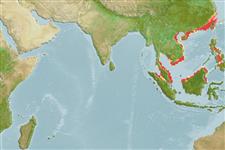>
Clupeiformes (Herrings) >
Engraulidae (Anchovies) > Engraulinae
Etymology: Stolephorus: Greek, stole, -es = garment + Greek, pherein = to carry (Ref. 45335).
More on author: Günther.
Environment: milieu / climate zone / depth range / distribution range
Οικολογία
Θαλασσινό(ά); εύρος βάθους 0 - 50 m (Ref. 189). Tropical; 29°N - 1°N, 98°E - 125°E (Ref. 189)
Western Pacific: China.
Μέγεθος / Βάρος / Age
Maturity: Lm ? range ? - ? cm
Max length : 9.0 cm SL αρσενικό/απροσδιόριστο; (Ref. 189); μεγ. δημοσιευμένο βάρος: 3.87 g (Ref. 124712)
This species is distinguished by the following characters: gill rakers on first gill arch, upper series 15-17 (modally 15), lower series 20-25 (25), total 35-41 (40); gill rakers on second gill arch, upper series 11-13 (11), lower series 18-22 (22), total 29-34 (33); gill rakers on third gill arch, upper series 8-10 (8), lower series 11-14 (11, 13), total 19-24 (19); gill rakers on fourth gill arch, upper series 7-8 (7), lower series 9-11 (9, 10), total 16-19 (17); prepelvic scutes 5-7 (6); upper jaw long, posterior tip slightly beyond or just reaching posterior border of preopercle; predorsal scute absent; posterior border of preopercle is convex, rounded; a pair of dark patches behind the occiput without a following pair of dark lines; no black spots below the eye and lower-jaw tip; pectoral fin is short, its length 15.8-16.4 % of SL; pelvic fin is short, its length 8.2-8.3 % of SL; posterior tip of depressed pelvic fin is not reaching to vertical through dorsal-fin origin (Ref. 128119).
Presumably coastal, pelagic and schooling, but more data needed.
Life cycle and mating behavior
Γεννητική Ωρίμανση | Αναπαραγωγή | Γεννοβολία | Αβγά | Γονιμότητα | Προνύμφες
Hata, H. and H. Motomura, 2018. Stolephorus continentalis, a new anchovy from the northwestern South China Sea, and redescription of Stolephorus chinensis (Günther 1880) (Clupeiformes: Engraulidae). Ichthyol. Res. 1-9. (Ref. 128119)
IUCN Red List Status (Ref. 130435: Version 2024-2)
Threat to humans
Harmless
Human uses
αλιεία: Εμπορικό(ά)
Εργαλεία
Special reports
Download XML
Διαδικτυακές πηγές
Estimates based on models
Preferred temperature (Ref.
123201): 24.1 - 29.3, mean 28.5 °C (based on 336 cells).
Phylogenetic diversity index (Ref.
82804): PD
50 = 0.5000 [Uniqueness, from 0.5 = low to 2.0 = high].
Bayesian length-weight: a=0.00617 (0.00340 - 0.01119), b=3.12 (2.97 - 3.27), in cm total length, based on LWR estimates for this species & Genus-body shape (Ref.
93245).
Τροφικό Επίπεδο (Ref.
69278): 3.3 ±0.4 se; based on size and trophs of closest relatives
Ελαστικότητα (Ref.
120179): Υψηλό, ελάχιστος χρόνος για διπλασιασμό πληθυσμού < 15 μήνες (Preliminary K or Fecundity.).
Fishing Vulnerability (Ref.
59153): Low vulnerability (10 of 100).
Nutrients (Ref.
124155): Calcium = 512 [181, 1,390] mg/100g; Iron = 2.49 [1.26, 4.42] mg/100g; Protein = 18.5 [16.7, 20.4] %; Omega3 = 0.278 [0.119, 0.629] g/100g; Selenium = 55.7 [21.8, 131.8] μg/100g; VitaminA = 38.3 [8.1, 184.7] μg/100g; Zinc = 2.42 [1.56, 3.92] mg/100g (wet weight);
